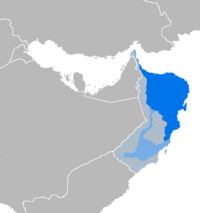Tefrian
Jump to navigation
Jump to search
This article is private. The author requests that you do not make changes to this project without approval. By all means, please help fix spelling, grammar and organisation problems, thank you. |
This article is a construction site. This project is currently undergoing significant construction and/or revamp. By all means, take a look around, thank you. |
| Tefrian | |
|---|---|
| پریشحشر Prayešeḥšur | |
 Flag of the Shardarate of Tefria | |
| Pronunciation | [ˈpʰɾäɪ̯(ə)ʃəħˌʃʉɾ] |
| Created by | Vrianne |
| Date | 2024 |
| Setting | Earth |
| Native to | Tefria |
| Ethnicity | Tefrian |
| Native speakers | 3.4 million ({{{date}}}) |
Asisic
| |
Early forms | Proto-Asisic
|
Map of areas where Tefrian is spoken
...as a majority language
...as a minority language
...as the language of law and government | |
Tefrian (/təˈfɹiːən/ tə-ꜰʀᴇᴇ-ən), natively called دلسان پریشحشر (di'lisān Prayešeḥšur [dəlɪˈsaːn ˈpʰɾäɪ̯(ə)ʃəħˌʃʉɾ]), is a West-Asisic belonging to the Asisic language family. It is, excluding diaspora, spoken entirely within Shardarate of Tefria, wherein it is recognized as the sole official language. It is the most spoken and most influential West-Asisic language, with about 3 million native speakers.
Classification
Name
History
Old Tefrian
Modern Tefrian
Phonology
Vowels
The Standardized Variety of Tefrian has 9 unique monophthongs, 5 diphthongs, and 5 triphthongs.
| Short | Long | |||||||
|---|---|---|---|---|---|---|---|---|
| Front | Central | Back | Front | Central | Back | |||
| unrounded | rounded | |||||||
| Close | i ◌ِ | ʉ ◌ُ | o̞ ~ u ◌ُ | iː ی | yː ۆ | uː و | ||
| Mid | e̞ ◌ِ | |||||||
| Open | a ◌َ | aː ا | ||||||
| -ɪ̯ | -ʊ̯ | -ʊ̯̃ | -ɪ̯e | -ʊ̯e | |
|---|---|---|---|---|---|
| a- | aɪ̯ | aʊ̯ | ãʊ̯̃ | aɪ̯e | aʊ̯e |
| e- | ẽʊ̯̃ | eɪ̯e | |||
| o- | õʊ̯̃ | oʊ̯e | |||
| ø- | øʏ̯e |
Notes:
- /i/ is near-close [ɪ] except in word-final open syllables.
- Urban speakers pronounce /ʉ/ as near-close [ʏ] while rural speakers pronounce it as central [ʉ] or [ɨ].
- Older rural speakers may distinguish between 2 close central vowels (such as [ɨ] and [ʉ]) which have merged for the majority of other speakers, including in the standard language.
- The vast majority have weakened the final /-e/ element of triphthongs to [-ə̆] or even dropped it completely.
- Rural speakers tend to monophthongize /øʏ̯e/ to [ø̞ː].
Consonants
The Standardized Variety of Tefrian has 30 unique consonants. Tefrian's is one of the only two West Asisic languages to retain pharyngeal and pharyngealized consonants, making its phonology semitic-like at face value.
| Labial | Alveolar | Post-alveolar | Velar | Uvular | Pharyngeal | Glottal | ||||
|---|---|---|---|---|---|---|---|---|---|---|
| plain | emphatic | plain | emphatic | |||||||
| Nasal | m م | n ن | ||||||||
| Plosive | voiceless | p پ | t ت | tˤ ط | t͡ʃ چ | k ک | q ق | ʔ ء | ||
| voiced | b ب | d د | (dˤ) | d͡ʒ ج | ɡ گ | |||||
| Fricative | voiceless | f ف | s س, ث | sˤ ص | ʃ ش | ʃˤ ض | x ~ χ خ | ħ ح | h ه | |
| voiced | v ڤ | z ز, ذ | zˤ ظ | ʒ ژ | ɣ~ ʁ غ | ʕ ع | ||||
| Rhotic | r ر | |||||||||
| Approximant | l ل | j ی | ||||||||
Notes:
- /b d͡ʒ ʔ sˤ zˤ x ɣ/ occur only in loanwords.
- /p t k/ are aspirated [pʰ tʰ kʰ], while /q/ is tenuis [q]. Some speakers, particularly in the Southwest, may also pronounce /p/ as tenuis [p].
- /d͡ʒ/ and /ʒ/ tend to be in free variation, with /d͡ʒ/ occurring in syllable-initial stressed positions and /ʒ/ occurring otherwise. Neutralization of /t͡ʃ/ and /ʃ/ in a similar fashion is also apparent in eastern urban speakers.
- /r/ is pronounced as a tap /ɾ/ when not geminated.


